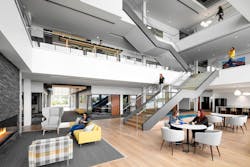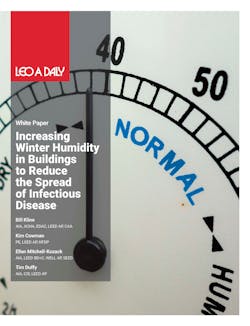How To Increase Indoor RH To Slow COVID-19 Without Harming Buildings
PRESS RELEASE
New research shows that higher relative humidity in buildings significantly slows COVID-19 and other airborne infectious disease transmission. However, the way most U.S. buildings are designed, this could lead to catastrophic damage.
A group of designers with Omaha, NE-based LEO A DALY have released a new whitepaper showing how various building types can be retrofitted to increase relative humidity without damage. The research covers a wide variety of existing construction and design conditions in a wide spread of geographic areas, using an innovative tool called Vapor Drive to conduct the analysis and offer recommendations.
EXECUTIVE SUMMARY
Interior relative humidity (RH) levels of at least 40 percent can substantially suppress all methods of COVID-19 spread, but especially airborne transmission. Yet most U.S. buildings in cold and mixed climates operate at much lower levels of humidity during the winter, usually 20 percent or less.
Simply adding humidifiers to raise the levels without a thorough investigation of the building envelope can cause catastrophic damage to the walls, ceilings and floors, reducing the lifespan of the building, increasing maintenance costs and energy consumption, and potentially causing additional health concerns such as mold growth and off-gassing of volatile organic compounds, which are health hazards.
There is a reason flu and colds spread more frequently during winter. Cold air lacks the moisture content of warmer months. Lack of moisture increases the number of infectious particles in the air and creates an atmosphere in which those particles can thrive. At the same time, dry air impairs human respiratory immune functions.
This is the science behind a March 2020 report from the Annual Review of Virology and the longtime research of Stephanie Taylor, M.D., a distinguished lecturer for the American Society of Heating, Refrigerating and Air Conditioning Engineers (ASHRAE), and a member of the group's new Epidemic Task Force.
Every building has its unique characteristics, but building modifications hinge primarily on mechanical systems, building enclosures and local climactic conditions. The new whitepaper offers solutions for building owners and operators who want to attain healthier levels of interior humidity to reduce the spread of COVID-19 and other illness.
To listen to the authors discuss this research, click here.

